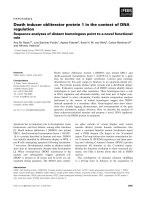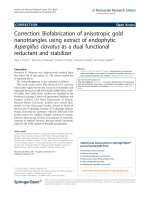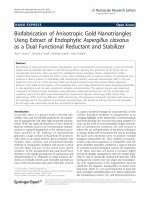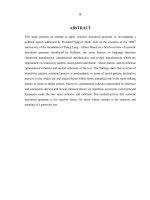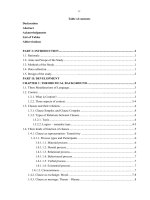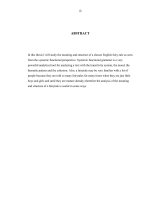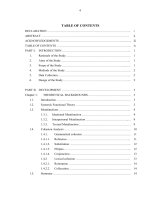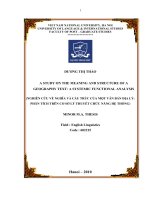EXPERIENTIAL MEANING OF BARACK OBAMAS COMMENCEMENT SPEECH a SYSTEMIC FUNCTIONAL LINGUISTIC
Bạn đang xem bản rút gọn của tài liệu. Xem và tải ngay bản đầy đủ của tài liệu tại đây (1.08 MB, 69 trang )
VIETNAM NATIONAL UNIVERSITY, HANOI
UNIVERSITY OF LANGUAGES AND INTERNATIONAL STUDIES
FACULTY OF ENGLISH LANGUAGE TEACHER EDUCATION
FACULTY OF LINGUISTICS AND CULTURE OF
ENGLISH-SPEAKING COUNTRIES
GRADUATION PAPER
EXPERIENTIAL MEANING OF
BARACK OBAMA'S COMMENCEMENT SPEECH:
A SYSTEMIC FUNCTIONAL
LINGUISTIC ANALYSIS
Supervisor:
Nguyễn Thị Minh Tâm, Ph.D
Student:
Đỗ Thị Vân Hà
Course:
QH2017.F1.E1.SPCLC
HÀ NỘI - 2021
ĐẠI HỌC QUỐC GIA HÀ NỘI
TRƯỜNG ĐẠI HỌC NGOẠI NGỮ
KHOA SƯ PHẠM TIẾNG ANH
KHOA NGƠN NGỮ VÀ VĂN HĨA CÁC NƯỚC NĨI TIẾNG ANH
KHĨA LUẬN TỐT NGHIỆP
PHÂN TÍCH NGHĨA TRẢI NGHIỆM TRONG
DIỄN VĂN TỐT NGHIỆP CỦA BARACK OBAMA
THEO LÝ THUYẾT NGÔN NGỮ HỌC
CHỨC NĂNG HỆ THỐNG
Giáo viên hướng dẫn: Nguyễn Thị Minh Tâm, Ph.D
Sinh viên:
Đỗ Thị Vân Hà
Khóa:
QH2017.F1.E1.SPCLC
HÀ NỘI - 2021
I hereby state that I, Đỗ Thị Vân Hà – class QH2017.F1.E1.SPCLC, being a
candidate for the degree of Bachelor of Arts (English Language Teacher Education Honors), accept the requirements of the College relating to the retention and use of
Bachelor’s Graduation Paper deposited in the library.
In terms of these conditions, I agree that the origin of my paper deposited in the
library should be accessible for the purposes of study and research, in accordance with
the normal conditions established by the librarian for the care, loan, or reproduction of
the paper.
Đỗ Thị Vân Hà
30/04/2021
ACKNOWLEDGEMENTS
I would like to express my sincerest thanks and gratitude towards all the
personages who have helped me in this endeavor. Without their active guidance, help,
cooperation and encouragement, I could not have completed this thesis.
I am profoundly grateful to my supervisor, Dr. Nguyễn Thị Minh Tâm, who spent
much of her valuable time supervising and guiding my study. Her timely advice,
meticulous scrutiny, and scientific approach have helped me, to a great extent, to
accomplish this task.
I would also like to thank my parents for giving me the greatest encouragement
and my friends who provided stimulating discussions as well as happy distractions to rest
my mind outside of my research.
i
ABSTRACT
This paper investigates the realization of experiential meaning in the 2020
commencement speech delivered on major television networks and online by Barack
Obama. The analytical framework of this study is based on the experiential meaning of
M. A. K. Halliday’s Systemic Functional Linguistics, consisting of transitivity model and
experiential grammatical metaphors. The results show that in Obama’s 2020
commencement address, relational processes were used the most frequently, followed by
mental and material ones. Likewise, Carrier and Attribute participants dominated the
speech, and the speaker also preferred to utilize Senser and Actor. Experiential
grammatical metaphors that involve the grammatical class shift from verbal groups into
nominal ones were the type that constituted the highest percentage of occurrence
frequency. These characteristics substantially contributed to the representation of the
Class of 2020 – the target audience – as experiencers, challenge fighters, aspirers, and
learners, the representation of Barack Obama – the speaker – as a companion of the
graduates, and the representation of the US, the American, the Covid-19 pandemic and
its impacts in the speech.
Keywords: systemic functional linguistics, experiential meaning, transitivity,
experiential grammatical metaphor, commencement speech
ii
TABLE OF CONTENTS
ACKNOWLEDGEMENTS ............................................................................................... i
ABSTRACT...................................................................................................................... ii
TABLE OF CONTENTS................................................................................................. iii
LIST OF FIGURES AND TABLES ................................................................................ v
LIST OF ABBREVIATIONS ........................................................................................... v
INTRODUCTION ............................................................................................................ 1
1. Background and rationale of the study ......................................................... 1
2. Aim of the study ........................................................................................... 2
3. Statement of research questions ................................................................... 2
4. Scope of the study ........................................................................................ 3
5. Significance of the study .............................................................................. 3
6. Methods of the study .................................................................................... 3
7. Organization of the study ............................................................................. 4
CHAPTER 1: LITERATURE REVIEW .......................................................................... 5
1.1 Systemic Functional Linguistics................................................................. 5
1.2 Three metafunctions of language ............................................................... 6
1.3 Experiential meaning .................................................................................. 6
1.3.1 Process................................................................................................. 7
1.3.2 Participant ......................................................................................... 10
1.3.3 Circumstance ..................................................................................... 13
1.4 Grammatical metaphors............................................................................ 15
1.5 Experiential metaphor .............................................................................. 16
1.6 Commencement address ........................................................................... 18
1.7 Review of previous related studies ........................................................... 19
CHAPTER 2: METHODOLOGY .................................................................................. 22
2.1 Research design ........................................................................................ 22
2.2 Data collection and description ................................................................ 22
iii
2.3 Data analysis framework .......................................................................... 22
2.4 Data analysis procedure ............................................................................ 24
CHAPTER 3: FINDINGS AND DISCUSSION ............................................................ 26
3.1 Baseline information ................................................................................ 26
3.2 Findings .................................................................................................... 27
3.2.1 Transitivity analysis .......................................................................... 27
3.2.2 Experiential grammatical metaphors ................................................. 34
3.3 Discussion................................................................................................. 37
3.3.1 Representation of the Class of 2020 – the target audience ............... 39
3.3.2 Representation of Barack Obama – the speaker ............................... 42
3.3.3 Representation of the US, the American, the Covid-19 pandemic and
its impacts – the circumstances .............................................................................. 43
CONCLUSION ............................................................................................................... 46
1. Summary and major findings ..................................................................... 46
2. Implications ................................................................................................ 47
3. Limitations of the study .............................................................................. 48
4. Suggestions for further studies ................................................................... 48
REFERENCES ............................................................................................................... 49
APPENDICES ................................................................................................................ 54
Appendix 1 ..................................................................................................... 54
Appendix 2 ..................................................................................................... 57
iv
LIST OF FIGURES AND TABLES
Figure 1.
The grammar of experience: types of process in English
7
Figure 2.
System network of transitivity
23
Table 1.
Process types, their meanings, and characteristic participants
10
Table 2.
Types of circumstantial element
13
Table 3.
Experiential GM recognized by Ravelli (1985)
17
Table 4.
Experiential GM recognized by Halliday (1999)
18
Table 5.
Combined model of experiential metaphor categorization
24
Table 6.
Process types of transitivity analysis in Barack Obama’s 2020 High
27
School Commencement Speech
Table 7.
Participant functions of transitivity analysis in Barack Obama’s
28
2020 High School Commencement Speech
Table 8.
Circumstantial elements of transitivity analysis in Barack Obama’s
32
2020 High School Commencement Speech
Table 9.
Experiential grammatical metaphors in Barack Obama’s 2020 High
School Commencement Speech
LIST OF ABBREVIATIONS
SFL
Systemic Functional Linguistics
GM
Grammatical metaphor
v
34
INTRODUCTION
1. Background and rationale of the study
Language is defined as the discrete combinatorial system humans use most for
communication and it can be construed as structural systems governed by rules that
combine discrete elements (e.g. words) into larger constructions (e.g. sentences and
conversations) (Hazen, 2015). These rules are known as grammar (Trask, 1999). Laying
the foundation for the formation and development of languages, grammar has always been
one of the principal orientations for research in the field of linguistics as can be seen from
several theories of grammar formulated over the years. For example, the formal approach
to the study of language has led to Generative Grammar, a grammatical model laid out
and promulgated by Chomsky in various publications (Chomsky, 1959, 1975, 1986,
1990). Exemplar theories of the functional approach include Functional Sentence
Perspective (Firbas, 1992), Functional Grammar (Dik, 1989), and Systemic Functional
Linguistics (SFL) (Halliday, 1985).
The work of Halliday and his associates (1985) has rendered SFL increasingly
acknowledged as a highly practical descriptive and interpretive framework for perceiving
language as a strategic meaning-making resource in which grammar is described as
systems instead of rules. These grammatical systems have a role to play in the construal
of meanings of different kinds, as Halliday claims that language is metafunctionally
organized (1985). He argues that all languages have three kinds of semantic components,
or more accurately, three metafunctions: ideational, interpersonal and textual.
Among these semantic components, ideational metafunction focuses on
construing human experiences of material and symbolic reality, which is known as
“experiential meaning”, and organizing those experiences into a logical whole defined as
“logical meaning”. Experiential meaning is concerned with the content of a discourse:
what kinds of activities are undertaken, how participants in these activities are described
and classified, and in which circumstances they participate in the activities. These
elements correspond to the “transitivity system” with its three components: process,
participants and circumstances (associated with the process) (Halliday, 1985). The
analysis of this strand of meaning in texts can therefore reveal the social and semiotic
contexts of language samples perceived from the speaker’s or writer’s viewpoint, a
fundamental element to explore the purposes of communication. Thus, the researcher has
elected to investigate the realization and effectiveness of experiential meaning in this
1
thesis.
In accordance with the aforementioned explanation, spoken language samples,
specifically public speeches, often with clear and predetermined delivery purposes,
implicate the speakers’ well-structured reflection of what they experience in the physical
and mental world - in other words, their social and semiotic contexts. Commencement
addresses, speeches given at graduation ceremonies, usually delivered by distinguished
speakers, serve to orient, inspire and encourage students who are going to be graduates.
Therefore, they tend to be analyzed as a message to the listeners rather than a
representation of the speakers’ viewpoints of the circumstances of the speech (Malendra
& Cahyono, 2013). However, commencements addressing Class of 2020, who graduate
in the middle of the Covid-19 outbreak and its subsequent increased socio-economic
instability, differ from their antecedents as they recount the social situations and express
the speakers’ points of view on these circumstances in more detail. Particularly, Barack
Obama’s 2020 High School Commencement Speech does reveal part of his political and
social perspectives on the current situations and how they orient his guiding message to
the soon-to-be graduates. Hence, it justifies the researcher’s choice of genres of language
sample to investigate.
2. Aim of the study
The research aims at exploring how experiential meaning and experiential
metaphor is realized in Barack Obama’s Class of 2020 High School Commencement
Speech. Additionally, it investigates how much these two linguistic components
contribute to the experiential success of the commencement address.
3. Statement of research questions
To achieve the aforementioned research aim, the researcher formulates the
following research questions:
How is experiential meaning expressed in Barack Obama’s Class of 2020 High
School Commencement Speech?
This question incorporates three sub-questions below:
(1) How is experiential meaning realized through the transitivity system in Barack
Obama’s Class of 2020 High School Commencement Speech?
(2) How is experiential meaning realized through experiential metaphors in
Barack Obama’s Class of 2020 High School Commencement Speech?
2
(3) What are the possible effects that experiential meaning realization could have
on the message of the speech?
4. Scope of the study
In this research, the writer will focus on the two linguistic notions, namely
transitivity and experiential GM, covered in experiential meaning of ideational
metafunction, a semantic system as part of the SFL approach to language study. Logical
meaning is not examined considering the “fluid boundaries” of clause complexes in
spoken language samples such as public speeches.
The experiential meanings will be analyzed using the transitivity system to
investigate the processes, participants, and circumstances involved. Concerning the
experiential GM, semantic elements and grammatical class shifts, will be the channel for
interpretation.
The text selected for the analysis of these linguistic aspects is Barack Obama’s
Class of 2020 High School Commencement Speech delivered online on May 17th, 2020.
5. Significance of the study
The results of this research are expected to be useful theoretically and practically.
(1) Theoretically, this study may be able to add a new insight regarding the topic
of linguistic analysis from an SFL perspective in spoken language, particularly with the
text type of public speech. Furthermore, it will assist in demonstrating the importance of
experiential meanings and experiential metaphors in imparting the speaker’s experience
of the world - in other words, the social and semiotic contexts, in a commencement
address.
(2) Practically, the findings of this research can provide the readers with a
portrayal of how to conduct an SFL analysis and suggest how they can incorporate their
experiences of the surrounding and organize those ideas in an effective public speech.
The study is conducted for the purpose of contributing to the pool of Systemic
Functional Linguistics research in the genre of public speech, especially commencement
addresses. Its results are hoped to become references for further studies in the same field.
6. Methods of the study
This study adopts a descriptive qualitative approach to research design with the
assistance of quantitative tools. Qualitative approach is utilized to describe, analyze and
3
interpret the collected data, specifically the realization of experiential meaning through
transitivity system and experiential metaphor through semantic elements and grammatical
class shifts in Obama’s Class of 2020 High School Commencement Speech. Quantitative
tool is adopted to measure the percentage of each element of experiential meaning
realized in the address.
7. Organization of the study
The study consists of three chapters, an Introduction, and a Conclusion. The
Introduction presents the background, rationale, scope, significance, and methods of the
study as well as the research question. Chapter 1 shows the theoretical background and
related previous studies of this paper. Chapter 2 explains the methodology of the study in
terms of research design, data collection, description, and analysis framework and
procedure. Chapter 3 reports the findings after data analysis and in-depth discussion of
those findings. The Conclusion summarizes the findings, points out the implications and
limitations of the study, and gives suggestions for further research.
4
CHAPTER 1: LITERATURE REVIEW
1.1 Systemic Functional Linguistics
There are two main approaches to the study of language: formalism and
functionalism (Darnell, 1999). Formal approaches, which reduce linguistic analysis to an
issue of symbol manipulation thus focusing on compositional semantics, syntax and word
classes (e.g. noun, verb), became predominant in linguistics with the advent of Noam
Chomsky’s Transformational-Generative Grammar (TGG) (1965) (Uson, 2012). In
contrast, functional approaches, with Michael Halliday, Simon Dik, and Jan Firbas as
their main proponents, were more concerned with the way people use language in context
to communicate (Halliday, 1978).
Among several functional linguistic approaches is Systemic Functional
Linguistics (SFL), a theory of language and discourse proposed by Halliday in the midnineteenth century. It was further developed by key figures in the field including Ruquiya
Hasan, James Martin, Christian Matthiessen, and David Butt (Patpong, 2009). Systemic
in SFL refers to a notion of language as a set of interrelated systems, or choices, for
conveying meanings, while Functional is concerned with what language does and how it
does it, as opposed to more structural approaches.
Halliday started to develop his theory in the 1960s. He was influenced by John
Firth, an English linguist, who introduced the conceptions of language as a network of
systems and the importance of context in the expression of meaning. The American
linguist, Benjamin Whorf also had a profound influence on Halliday, with his insistence
on the impact of environment on language (i.e. one needs to be in a specific context to
understand the meaning of an utterance), and his idea of situational multiplicities of
languages. Halliday also inherited from the functional approach of the Prague linguistic
circle, especially with regard to textual metafunction (Flowerdew, 2013).
SFL places emphasis on the idea that language is shaped by one’s experience of
communication in sociocultural contexts. Therefore, SFL associates the conception of
external explanation with social factors, that is, it conceives language as part of a social
system of meaning or “social semiotics” (Halliday, 1978). In this model of language, the
basis for language use is to make choices from the intricate network of systems that give
structure to language and map such choices simultaneously onto linguistic expressions in
a meaningful way. Not only is language in use shaped by choice, it is under the influence
of social contexts namely context of situation and context of culture. The former relates
5
to the broad socio-cultural environment, including ideology, social conventions and
institutions; the latter refers to the specific situations within the environment (Droga &
Humphrey, 2002).
1.2 Three metafunctions of language
As a macro-level theory of language, SFL also provides a detailed account of
functional grammar which underscores the notion that one’s selection of words and clause
structures is affected by the roles that language plays in his interactions. This can be
clarified by viewing grammar from the perspective of three discrete yet concurrent
linguistic macro-functions, which Halliday named ‘metafunctions’, the most general
categories of meaning potential that are common to all uses of language: textual,
interpersonal, and ideational.
(i) The textual metafunction is concerned with the construction of text, and how
it is held together to keep information flowing from one clause to another. This refers to
‘clause as a message’.
(ii) The interpersonal metafunction sees ‘clause as an exchange’ of information
to enact social relationships since interactions are intrinsic to every use of language.
(iii) The ideational metafunction relates to the way in which language acts as a
reflection of reality, of the physical and social world in which we live and of the world of
our consciousness. It is generally classified into two components embodying different
modes of conveying experience: the experiential meaning and the logical meaning. The
former is to do with ‘clause as the representation’ of one’s experiences and the latter refers
to the dependency and interdependency relationships among clauses.
1.3 Experiential meaning
As is mentioned, in SFL the ideational metafunction refers to the representation
of human experiences both as the external world as well as the internal consciousness of
individuals, which is defined as experiential meaning.
According to Halliday (1994), experiential meaning is construed in grammar
through the system of transitivity, incorporating processes (actions, events and states),
participants (in the processes), and circumstances (in which the processes occur).
They
slowly
unlocked
the door.
Participant
Circumstance
Process
Participant
6
1.3.1 Process
Figure 1
The grammar of experience: types of process in English
Note. Reprinted from Halliday’s Introduction to Functional Grammar (4th ed., p.216),
by M. A. K. Halliday and M. I. M. Matthiessen, 2014. London: Edward Arnold. Copyright
2014 by M.A.K. Halliday and M.I.M. Matthiessen.
In English, clauses can be categorized into six types of process including: material
process, mental process, relational process, behavioral process, verbal process, and
existential process (Halliday, 1985; Halliday, 1994; Halliday, 2014):
(1) Material process is the process of doing and happening, and construing actions,
activities, and events in the physical world. The doer is known as the Actor, an obligatory
participant of this process. This participant brings about the unfolding of the process
through time, leading to an outcome that is different from the initial phase of the unfolding.
This outcome may be confined to the Actor itself, in which case there is only one
participant in the process. Such a ‘material’ clause represents a ‘happening’ and can be
called ‘intransitive’. Beside representing the action as involving only the Actor, some
material processes also affect or are ‘being done to’ another participant called the Goal,
7
in a ‘transitive’ material clause. In addition to the two inherent participant roles, there is
an extra component called Circumstance, which provides supplementary information on
the “when, where, how, and why” of the process. Additionally, the nature of the outcome
affecting the Actor of an ‘intransitive’ clause and the Goal of a ‘transitive’ one is the
criterion to recognize more delicate subcategories of material clauses.
(i) Creative clause: the outcome is the coming into existence of the Actor
(intransitive) or the Goal (transitive).
Accidents like this
She
happen
makes
her own clothes.
all the time.
Actor
Process: material, creative
Goal
Circumstance
(ii) Transformative clause: the outcome is the change of some aspect of an already
existing Actor (intransitive) or Goal (transitive).
They
She
He
destroyed
sent
has gone
all the evidence.
a letter.
Actor
Process: material, transformative
Goal
to China.
Circumstance
It is possible that the Actor may not appear explicitly in the clause, for example
in a passive form. In this case, the participant affected by the process is still coded as Goal,
since its semantic relationship to the process has not changed.
The oil
is added
slowly.
Goal
Process: material, transformative
Circumstance
In addition to the Actor and the Goal, material processes may have other extra
participants namely Scope (that which remains unaffected by the action), Recipient (the
receiver of goods/ services), Client (for whom/which the action occurs), and Attribute (a
quality ascribed to an entity). (see 1.3.2)
(2) Mental process is the process of sensing, perception, cognition, intention, and
emotion. Grammatically, all mental processes involve two participants: Senser (the
conscious being who is involved in a mental process by feeling, thinking, wanting, or
perceiving) and Phenomenon (that which is felt, thought, wanted, or perceived by the
Senser) (Eggins, 1994; Halliday, 1994). Mental process verbs can be divided accordingly
into four subtypes: Emotive (e.g. liking, loving, fearing, etc.), Cognitive (e.g. dreaming,
knowing, understanding, etc.), Desiderative (e.g. wanting, desiring, agreeing, etc.), and
8
Perceptive (e.g. seeing, hearing, etc.) (Halliday & Matthiessen, 2014).
The car
pleased
him.
Phenomenon
Process: mental, emotive
Senser
He
never discovered
the exact address.
Sensor
Process: mental, cognitive
Phenomenon
I
may crave
a cigarette.
Sensor
Process: mental, desiderative
Phenomenon
He
could not see
anything.
Sensor
Process: mental, perceptive
Phenomenon
(3) Relational process is the process of being, which serves to characterize and to
identify abstract relations. Unlike the case of material processes, a participant does not
affect the other participant in a physical sense in a relational process. Examples are “I am
hungry,” and “I am a student”. This kind of process can be analyzed according to two
modes (i.e. attributive and identifying) as followed:
(i) Attributive relational process: the two participants are the Carrier (the entity
that ‘carries’ the attribute) and the Attribute.
The room
She
The drink
seemed
had
must have cost
cold.
terrible things to say.
a bomb.
Carrier
Process: relational, attributive
Attribute
(ii) Identifying relational process: the two participants are the Value (general
category) and the Token (specific embodiment).
The strongest shape
is
the triangle.
Value
Process: relational, identifying
Token
(4) Behavioral process is the process of behaving, concerned with physiological
and psychological behaviors. Behavioral processes “represent outer manifestations of
inner workings, the acting out of processes of consciousness and physiological states”
(Halliday, 1994). It lies over the boundary between mental and material processes, thus
usually expressing conscious physical acts involved in perception (e.g. ‘see’ - mental) vs.
9
‘watch’ - behavioral), and acts reflecting mental states (e.g. ‘frown’, ‘laugh’, etc.).
Normally, there is only one participant, the Behaver, who is a conscious being.
Specifications to the process can sometimes be added with another participant, the
Behavior.
We all
She
laughed.
gave
a faint sigh.
Behaver
Process: behavioral
Behavior
(5) Verbal process is the process of saying and it is intermediate between
relational and mental processes. One obligatory participant of this process is the Sayer
and often the Receiver, the entity addressed by the saying, is also present. In some cases,
the verbal processes may be directed at another participant, known as the Target. The
content of the utterance is called the Verbiage.
He
I
The report
repeated
explained
criticizes
the warning.
what it meant.
to her
Sayer
Process: verbal
Receiver
his policy.
Target
Verbiage
(6) Existential process is the process of existing. It is characterized by the subject
‘there’ and incorporates only one participant called the Existent. An Existent can be any
sort of phenomenon, whether concrete or abstract.
There
is
a restaurant
around the corner.
Process: existential
Existent
Circumstance
1.3.2 Participant
According to Halliday (1978), participant is “the person, creature, object,
institution or abstraction that is involved in a process”. In experiential meaning,
participants are incorporated in the six processes. There are a number of specific ways in
which participants can participate in processes; they can act out the process, they can
sense through it, they can be affected by it, etc. The number and type of participants
involved are determined by what kind the process belongs to. Table 1 below summarizes
the common participants according to six process types.
Table 1
Process types, their meanings, and characteristic participants
10
Process type
Meaning
Participants,
directly involved
Participants, obliquely
involved
material:
action
event
‘doing’
‘doing’
‘happening’
Actor, Goal
Recipient, Client; Scope;
Initiator; Attribute
behavioral
‘behaving’
Behaver
Behavior
mental:
perception
cognition
desideration
emotion
‘sensing’
‘seeing’
‘thinking’
‘wanting’
‘feeling’
Senser, Phenomenon
Inducer
verbal
‘saying’
Sayer, Target
Receiver; Verbiage
relational:
attribution
identification
‘being’
‘attributing’
‘identifying’
Carrier, Attribute
Token, Value
Attributor; Beneficiary
Assigner
existential
Existent
Note. Reprinted from Halliday’s Introduction to Functional Grammar (4th ed., p.311),
by M. A. K. Halliday and M. I. M. Matthiessen, 2014. London: Edward Arnold. Copyright
2014 by M.A.K. Halliday and M.I.M. Matthiessen.
With regards to material processes, there are two directly involved participants,
namely Actor and Goal. While the former is an inherent participant in both intransitive
and transitive material clauses, the latter is inherent only in transitive clauses. In addition
to these two roles, there are a number of other participant roles that may be involved in
the process of a ‘material’ clause; these are: Recipient, Client, Scope, Initiator, and (more
marginally) Attribute. Both Recipient and Client construe a ‘benefactive’ role,
representing a participant that is benefiting from the performance of the process, in terms
of either goods or services. Specifically, the Recipient is one that goods are given to, and
the Client is one that services are done for. Meanwhile, the Scope of a ‘material’ clause
is not in any way affected by the performance of the process. Instead, it construes either
the domain over which the process takes place (as with the street in She crossed the street)
or the process itself (as with a game of tennis in They played a game of tennis). As for
Attribute, although it inherently belongs to the realm of relational clauses, it does enter
into material clauses in a restricted way. It may be used to construe the resultant
qualitative state of the Actor or Goal after the process has been completed or specify the
state which the Actor or Goal is in when it takes part in the process. The Attribute, in
other words, is an optional added specification of material clauses.
11
They
gave
him
a house.
Actor
Process: material, transformative
Recipient
Goal
They
built
him
a house.
Actor
Process: material, transformative
Client
Goal
They
She
played
crossed
a game of tennis.
the street.
Actor
Process: material, transformative
Scope
They
washed
the plates
clean.
Actor
Process: material, transformative
Goal
Attribute
In mental clauses, Senser and Phenomenon are participants directly involved in
the process while Inducer may get obliquely involved. The role of Senser construes a
participant as animate, being one that ‘senses’, and Phenomenon is the other element in a
mental clause and is the thing, act, or fact that is ‘sensed’. Inducer, meanwhile, gives rise
to the process of ‘sensing’.
Your advertisements
should remind
people
of your great location.
Inducer
Process: mental, cognitive
Senser
Phenomenon
In respect of relational clauses, Carrier and Attribute or Token and Value are the
two inherent participants (see 1.3.1). In attributive clauses, the Carrier is or has the
Attribute and in identifying clauses the Token is the Value. Both identifying and
attributive relational processes have the option of ‘assignment’: they may be configured
with a third participant representing the entity assigning the relationship of identity of
attribution. In the case of identifying clauses, this is the Assigner; in the case of attributing
clauses, this is the Attributor.
They
made
Mary
happy.
Attributor
Process: relational, attributive
Carrier
Attribute
They
made
Mary
their leader.
Assigner
Process: relational, identifying
Token
Value
Meanings and characteristics of other participants of behavioral, verbal, and
12
existential processes can be found in section 1.3.1.
1.3.3 Circumstance
The summary of different types of circumstantial elements in experiential
meaning is shown in the following table.
Table 2
Types of circumstantial element
Type
enhancing
1 Extent
2 Location
3 Manner
Wh-item
Examples of realization
distance
how far?
for; throughout
‘measured’ nominal group
duration
how long?
for; throughout
‘measured’ nominal group
frequency
how many
times?
‘measured’ nominal group
place
where?
[there,
here]
at, on, near; to, into,
(away) from, off; behind,
above, alongside ...
adverb of place: abroad,
home, upstairs, outside;
down, behind; left, right,
straight ...; there, here
time
when?
[then,
now]
at, in, on; to, until, till,
towards, into, from, since,
during, before, etc.
adverb of time: today,
yesterday; now, then
means
how?
[thus]
by, through, with, by means
of, out of [+ material], from
quality
how?
[thus]
in + a + quality (e.g.
dignified) + manner/ way,
with + abstraction (e.g.
dignity); according to;
adverbs in -ly, -wise; fast,
well; together, separately,
respectively
comparison
how? what
like?
like, unlike; in + the
manner of ...
adverbs of comparison
differently
degree
how
much?
to + a high/low/...
degree/extent; adverbs of
13
degree much, greatly [often
collocationally linked to
lexical verb, e.g. love +
deeply]
4 Cause
5 Contingency
extending
elaborating
projection
6 Accompaniment
7 Role
reason
why?
because of, as a result of,
due to, for, through
purpose
why? what
for?
for, for the sake of, in the
hope of
behalf
who for?
for, in favor of, against, on
behalf of
condition
why?
in case of, in the event of
default
in default of, short of,
without
concession
despite, in spite of
comitative
who/what
with?
with; without
additive
and who/
what else?
as well as, besides; instead
of
guise
what as?
as, by way of, in the
role/shape/guise/form of
product
what into?
into
what
about?
about, concerning, on, of,
with reference to
8 Matter
9 Angle
source
according to, in the words
of
viewpoint
to, in the view/opinion of,
from the standpoint of
Note. Reprinted from Halliday’s Introduction to Functional Grammar (4th ed., p.313314), by M. A. K. Halliday and M. I. M. Matthiessen, 2014. London: Edward Arnold.
Copyright 2014 by M.A.K. Halliday and M.I.M. Matthiessen.
Typically, circumstantial elements occur freely in all types of process, and with
essentially the same significance wherever they occur (Halliday & Matthiessen, 2014).
They belong to four general categories, serving four main purposes: enhancing, extending,
elaborating, and projection.
Enhancing circumstances augment the configuration of process + participants
14
through the specification of (1) extent or (2) location in time or space of the unfolding of
the process, and/or the (3) manner, (4) cause, or (5) contingency of the unfolding of the
process.
Extending circumstances augment the configuration of process + participants
through the specification of an element that stands in an extending relation to one of the
participants in relation to its participation in the process. Specifically, (6) accompaniment
is a form of joint participation in the process and represents the meanings ‘and’, ‘or’, ‘not’
as circumstantials.
Elaborating circumstances augment the configuration of process + participants
through the specification of the role in which one of the participants participates in the
process: this participant is elaborated circumstantially. There is only one type of
elaborating circumstance: (7) role, which construes the meanings ‘be’ and ‘become’
circumstantially.
Projection circumstances augment the configuration of process + participants
through the specification of (8) matter, the circumstantial equivalent of the Verbiage
(‘that which is described, referred to, narrated, etc.’), and (9) angle, the circumstantial
equivalent of the Sayer of a verbal process or the Senser of a mental clause.
1.4 Grammatical metaphors
Grammatical metaphor (GM), initially suggested in the work of Halliday (1985)
and Ravelli (1985), is a key concept and a remarkable progress in SFL as it enriches the
theoretical framework of language description and contributes to the contextual
understanding of language (Kilpert, 2003; Ravelli, 2003).
According to Halliday and Matthiessen (1999), the appearance of GM is inherent
in the natural development of the plane of content in a language. The content system of
language evolves by extending the congruent pattern between semantic and lexicogrammatical strata. This separation of the congruent pattern between two levels of content
plane opens up the possibility of metaphorical expressions. Yang (2013) also sees GM as
a phenomenon automatically arising from the realization of meanings through wordings
in a language (Yang, 2013). He explains that in the development of human languages,
this relationship evolves first as the patterns in which a semantic meaning is congruently
mapped onto a grammatical expression. For example, congruently, the semantic unit of
command is realized by imperative clauses. The congruent pattern is not the only form of
realization because a language has the inherent power of realigning the mapping between
15
semantic meanings and grammatical realizations. For instance, the meaning of command
can be realized by an interrogative clause or even a declarative clause. In other words,
there is the possibility of metaphorical realization of a particular meaning in a language.
Therefore, Halliday and Matthiessen defined GM as “the phenomenon whereby a
set of agnate forms is present in the language having different mappings between the
semantic and the grammatical categories” (1999). In other words, GM introduces a stratal
tension between lexico-grammar (wording) and discourse semantic (meaning) so the
language has to be read on at least two levels (i.e. metaphorically), with one level directly
reflecting the grammar, and beyond that another symbolically related level of semantics.
1.5 Experiential metaphor
According to Halliday (1985), GM can be categorized into interpersonal and
ideational GMs. Two types of interpersonal GM are metaphors of mood and metaphors
of modality. Ideational GM consists of experiential and logical GM (Martin, 1992).
Experiential GM is a powerful resource in the grammar of a language, by which
the expression of experiential meanings such as processes, qualities and entities is
extended in important ways beyond their default encodings. Specifically, it is the
metaphorical construal of meaning where process is realized by a noun or a nominal group,
and quality is realized by an adjective or an adjectival group in lexico-grammar. In other
words, different grammatical forms can be borrowed to express different meanings
depending on the contexts (Yang, 2012). By doing so, speakers and writers can reorganize
their spoken and written language into concise, coherent expressions (Christie, 2012;
Christie & Derewianka, 2008; Eggins, 2004; Gebhard, Chen & Britton, 2014). These
characteristics align closely with the functions of experiential meaning, which justifies
the analysis of experiential GM realization in this study.
Normally, the congruent relationship between semantics and lexico-grammar is
as follows (Halliday & Matthiessen, 2004):
-
Nouns construe participants (things);
-
Verbs construe processes (events);
-
Adjectives construe attributes (properties/ epithets);
etc.
However, in the experientially metaphorical mode of realization, referred to as
“the marked clause structure”, the following re-mappings may be evident:
-
A process realized by a verb may be coded as a participant – a noun/ nominal
16
group;
-
An attribute realized by an adjective may be coded as a participant;
-
An element realized by a group/ phrase may be coded as a Thing in the
nominal group;
etc.
For example, in the table below, the process “broke”, manifested as a verb in the
first sentence, becomes a nominal group in the second. This means the experiential
meaning is packed into that nominal group, “my BROKEN LEG”.
1
2
Because
Due to
I broke my leg,
Clause 1
my BROKEN LEG,
Nominal group
I could not take part in the race.
Clause 2
I could not take part in the race.
Main clause
Ravelli (1985) and Halliday (1998) proposed that experiential GM be categorized
on the basis of the metaphoric shifts from one semantic element to another. Ravelli (1985)
classifies experiential GM into six types by “identifying the participants, processes and
circumstances of each clause, and determining if the meaning behind the clause is realized
congruently or not”. These types of GM are summarized in the table below.
Table 3
Experiential GM recognized by Ravelli (1985)
No.
Semantic choice
Metaphorical realization class
Congruent realization class
1a
Material process
Thing/nominal group
Verbal group
1b
Mental process
Thing/nominal group
Verbal group
1c
Relational process
Thing/nominal group
Verbal group
1d
Behavioral process
Thing/nominal group
Verbal group
1e
Verbal process
Thing/nominal group
Verbal group
2
Process
Epithet, Classifier/adjective
Verbal group
3a
Quality of a Thing
Thing/nominal group
Adjective
3b
Quality of a process
Epithet, Classifier/adjective
Adverb
3c
Quality of a process
Thing/nominal group
Adverb
4a
Participant
Classifier/adjective
Nominal group
4b
Participant
Thing/nominal group
Nominal group
5a
Circumstance
Process/verbal group
Prepositional phrase
5b
Circumstance
Epithet, Classifier/adjective
Prepositional phrase
17

